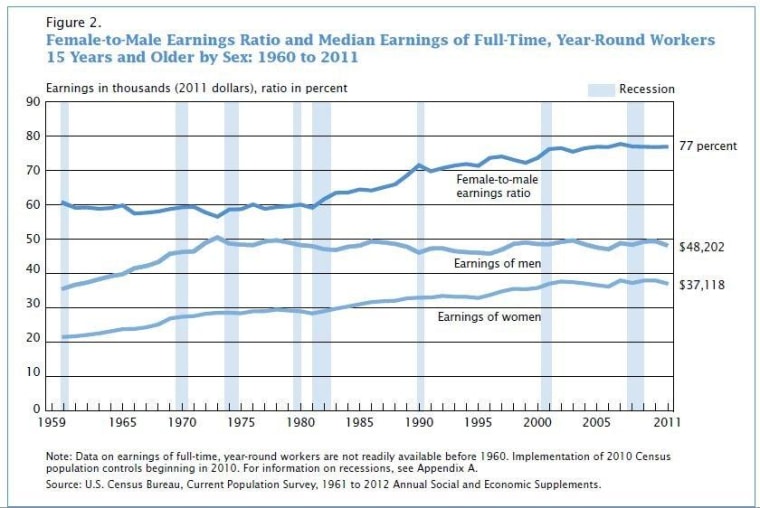The gap between women’s and men’s pay remained about the same for the fourth straight year in 2011, as both genders got slammed by lower wages.
Women earned 77 cents for every dollar a man earned in 2011, the Census Bureau said this week as part of its extensive annual report on income and poverty.
The female-to-male earnings ratio for full-time workers has been little changed for four years, after hitting a record high of 78 percent in 2007.
Experts say the latest figures show that women aren’t making significant gains in terms of earning power – but men aren’t either.
"It’s not that gap is not closing,” said Katherine Gallagher Robbins, senior policy analyst with the National Women’s Law Center. “It’s that wages are sort of flattening.”
For men who work full-time and year-round, inflation-adjusted median earnings fell about 2.5 percent between 2010 and 2011, to $48,202, according to the Census Bureau. For women working full-time, the median, or midpoint, of annual earnings also fell by about 2.5 percent, to $37,118.
Experts say that there are other factors at work besides the lousy job market. The wage gap narrowed slowly and in fits and starts through the 1980s and 1990s, but further gains have been tough to come by.
“As a broad trend, I think we have plateaued in a way, or we may have plateaued,” said Ariane Hegewisch, study director with the Institute for Women’s Policy Research.
Women still face some big hurdles, especially those who want to have children and still advance in their careers, she said. Child care can be quite expensive, and some women may not be willing to put in the long hours required to make it to the top when their children are young.
The wage gap has persisted even though women have made huge inroads in traditionally male-dominated fields and positions. There have been several high-profile examples of that phenomenon, including Yahoo Inc.’s decision to appoint a pregnant Marissa Mayer to the role of chief executive.
Despite such gains, research shows that women generally take home less money each week even when they are doing the same job.
Women also now get postsecondary degrees at higher rates than men, and more education generally translates into higher earnings over the course of a lifetime. But experts note that what people study, and the fields they go into, matters as well.
“There’s a huge gender segregation there,” Hegewisch said. “Men get more technical (degrees) and women are in education and social work and the kind of softer sciences, and they pay less.”
The recession of 2007-09 was so hard on male-dominated fields such as construction that some referred to it as the mancession. With men hit so hard, 38 percent of women outearned their husbands in 2009, a 3 percentage point increase from 2008.
But as the economy began recovering in 2009, it was women who fared worse in the job market.
The situation has since become more of a mixed bag. In August, the unemployment rate for men was 8.3 percent. For women, it was 7.8 percent.
“I think the story right now is that everyone is struggling,” Robbins said. “Often when people think about the wage gap they think about it as women as compared to men. A lot of (families) have both women and men who are working. We think of it as a family security issue.”
Related: States with the biggest wage gap between men, women
